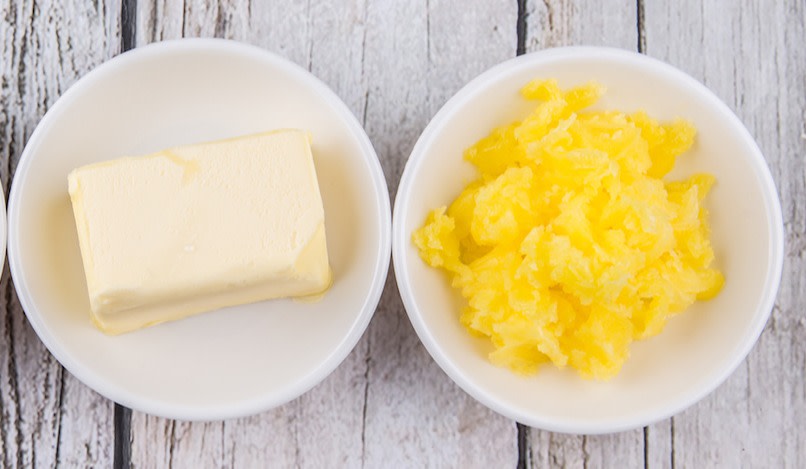Ghee vs. Clarified Butter: Similarities and Differences Between Ghee and Butter
Written by MasterClass
Last updated: Sep 30, 2021 • 4 min read
There are so many similarities between ghee and clarified butter that the two are more often than not used interchangeably. But there is a difference, and knowing it can help to unlock these wonder ingredients’ full potential in the kitchen.
Learn From the Best
What Is Clarified Butter?
Clarified butter is butter with the water and milk proteins removed, leaving a composition of 99-100% pure butterfat. Before that, butter is 16-17% water and 1-2% milk proteins (also known as milk solids).
To make clarified butter, you simmer unsalted butter in a pan over low heat. The butter will foam as its water content evaporates, and then clumps of white milk solids will form and start to sink to the bottom of the pan. At this point, you pour the contents through a mesh strainer lined with cheesecloth and into a heatproof bowl or jar. With the milk solids trapped in the strainer, you’re left with clarified butter—or as it’s sometimes known, liquid gold.
Left at room temperature, the liquid will solidify and can be safely stored in the pantry in an airtight jar for several months. Alternatively, you can keep it in the fridge for up to one year.
What Is Ghee?
Ghee is one type of clarified butter. It is popular in Indian cooking and is also an ingredient in the region’s traditional medicine, which is known as Ayurveda.
Making ghee involves following the first steps in the process for clarifying butter. Then, instead of removing the butter from the heat once the milk solids separate, you leave it to cook a little while longer. The proteins will turn golden brown, sink to the bottom of the pan and start giving off a slightly toasted aroma. This is when it’s time to strain. (Without the solids entirely strained out, you’ve got brown butter, a.k.a the French specialty, beurre noisette.)
What Is the Difference Between Ghee and Clarified Butter?
While you can use ghee and clarified butter almost interchangeably, there are a few differences.
- Taste. The extra cooking time gives ghee a nutty flavor.
- Provenance. Ghee originated in India and tends to feature in South Asian cuisine, while clarified butter is most often seen in the food of its mother country, France.
- Availability. Ghee is more widely sold in grocery stores, particularly specialty grocers, while clarified butter may require preparation at home.
What Are the Similarities Between Ghee and Clarified Butter?
Ghee and clarified butter share many of the same characteristics. Their similarities include:
- A high smoke point. With the milk solids removed, both ingredients have a higher smoke point than butter, which burns and generates free radicals at high heat. This makes both ghee and clarified butter good for sautéing, frying and roasting, whereas butter really only suits baking and low-heat cooking.
- A longer shelf life. Without the milk solids that make butter spoil, both clarified butter and ghee are shelf-stable at room temperature for a long time. This is partly why ghee became so popular in the warm climate of India.
- Health benefits. Both products contain fatty acids. They’re also digestible by most people with lactose intolerance because the sugar lactose and protein casein are removed with the butter’s milk solids. Ghee and clarified butter also tend to pass muster with people who follow a Paleo diet, avoiding dairy products (although it’s still not okay for vegans).
What Is the Difference Between Ghee and Regular Butter?
Ghee is butter that has been clarified to remove its milk solids and water content, leaving a composition that’s 99-100% pure fat. This process gives it a few key differences from regular butter:
- Ghee has a higher smoke point than butter, so it won’t burn when you are cooking above a low temperature.
- Ghee is shelf-stable at room temperature for longer than butter because it is free of the milk solids that make butter spoil. Ghee will keep in the pantry for several months.
- Ghee is digestible by most people who are lactose-intolerant because the sugar lactose and protein casein are removed with the butter’s milk solids.
- Ghee also tends to be suitable for those who avoid dairy products. However, traditional ghee is not suitable for those on a vegan diet, as it is still of animal origin.
How Is Ghee Used in Cooking?
You can use ghee instead of regular butter or cooking oil in almost any recipe, apart from baking. It often appears:
- As a cooking fat for vegetables and meats at higher temperatures.
- As a butter substitute for people who are lactose intolerant or where you want a nuttier flavor.
- As a part of Indian dishes, such as to coat the rice in biryani, spread on naan, or stew carrots for the dessert gajar ka halwa.
How Is Clarified Butter Used in Cooking?
Clarified butter is used similarly to ghee. Commonly it’s seen:
- As a cooking oil for all kinds of vegetables and meats, especially where the nutty flavor of ghee wouldn’t suit.
- As a butter substitute for people who are lactose intolerant.
- As a way to give risotto grains and pasta a glossy coating.
- As a part of French dishes, including hollandaise sauce.
Become a better home cook with the MasterClass Annual Membership. Gain access to exclusive video lessons taught by culinary masters, including Chef Thomas Keller, Alice Waters, Gordon Ramsay, and more.
